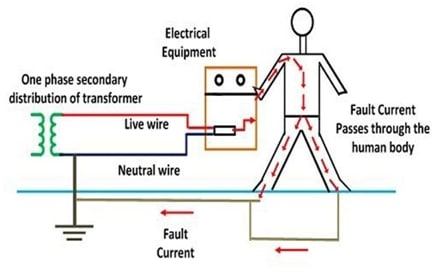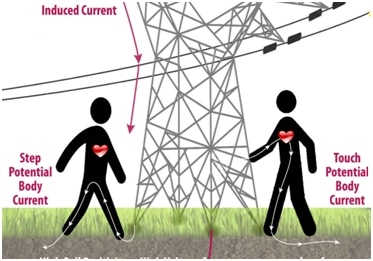Hello everybody, I’m Yasser, I am electrical engineer and I often publish in this blog. In one of my articles I said “As only few mille amperes can kill a human in a part of second, safety always is the big concern for electrical engineers and protection systems designing gets much more attention”.
Therefore we are going to continue talking about safety in many articles and this time it is earthing turn.

Figure.1 Electrical System without Earthing
In this article I will discuss what earthing is? What is the importance of earthing? And how can we install an earthing system.
What is earthing?
If the surface of an equipment has leakage current there will be two dangerous problems.
First, if any person touched the surface, that current will flow through his body and shock him, which can be deadly shock. Secondly, if this leakage current remains on the surface of the equipment, it may increase the temperature and cause damage to the equipment. Therefore, there is always a need to find another safety path to that current. And guess what is existing everywhere, it is earth.
But the question now is the earth conductive and can allow the current to path through it? Actually the answer is no it is very poor because of its high resistivity, but if the area for current to flow is big, then the resistance will be small and current can find a path.
What’s the importance of earthing?
Briefly, it’s for safety in normal and fault conditions. Safety of personal in the first place and then of equipment by releasing the leaked current from the surface, the area around and the place under the equipment [step and touch potential] at all the steps and components of electrical system from generation to transmission and distribution of electricity to end user.
What are the main components of earthing system?
The earthing system consists of three main parts:
- Relatively low resistance solid.
- Ground electrodes, usually copper rods, penetrate into the ground to achieve lower resistance.
- A conductor that connects the electrode to the body of the equipment meant to be earthed.
To install an earthing system the first design step is to measure the resistance of the earth. There are many factors that needs to be considered e.g. the resistivity of the soil [kind of soil], the percentage of moisture in soil, the number of rods connected in parallel and the depth of electrodes under the ground.

Figure.2 Step and Touch Potential
Briefly to install an earthing system you will:
- Calculate the relative resistivity of the soil depending on the number and length of rods used and the horizontal and vertical correction factor depending on the distance between each two rods and length of rods.
- Increase or decrease the number of rods to achieve the required resistance or use chemicals to enhance the specs of the soil.
- Choose the proper type of rod depending on the environment and probability of corrosion.
- Calculate the cross section area of the conductor connecting the rods to equipment depending on the expected short circuit current.
Conclusion
Finally the earthing system is very important and critical, although we don’t experience its importance usually until there is an abnormal condition.
If you have an earthing system, make sure that it helped you to avoid fires and protected persons and equipment. And if you don’t have, then contact a company that can help you with it.
Yasser.
Do you think this article is useful? Have you ever installed an electrical earthing system?
thank you… it is full of knowledge